Answered step by step
Verified Expert Solution
Question
1 Approved Answer
Project Tasks The project manager for the development of a bioterrorism response plan has created the WBS for the project, estimated the number of workdays
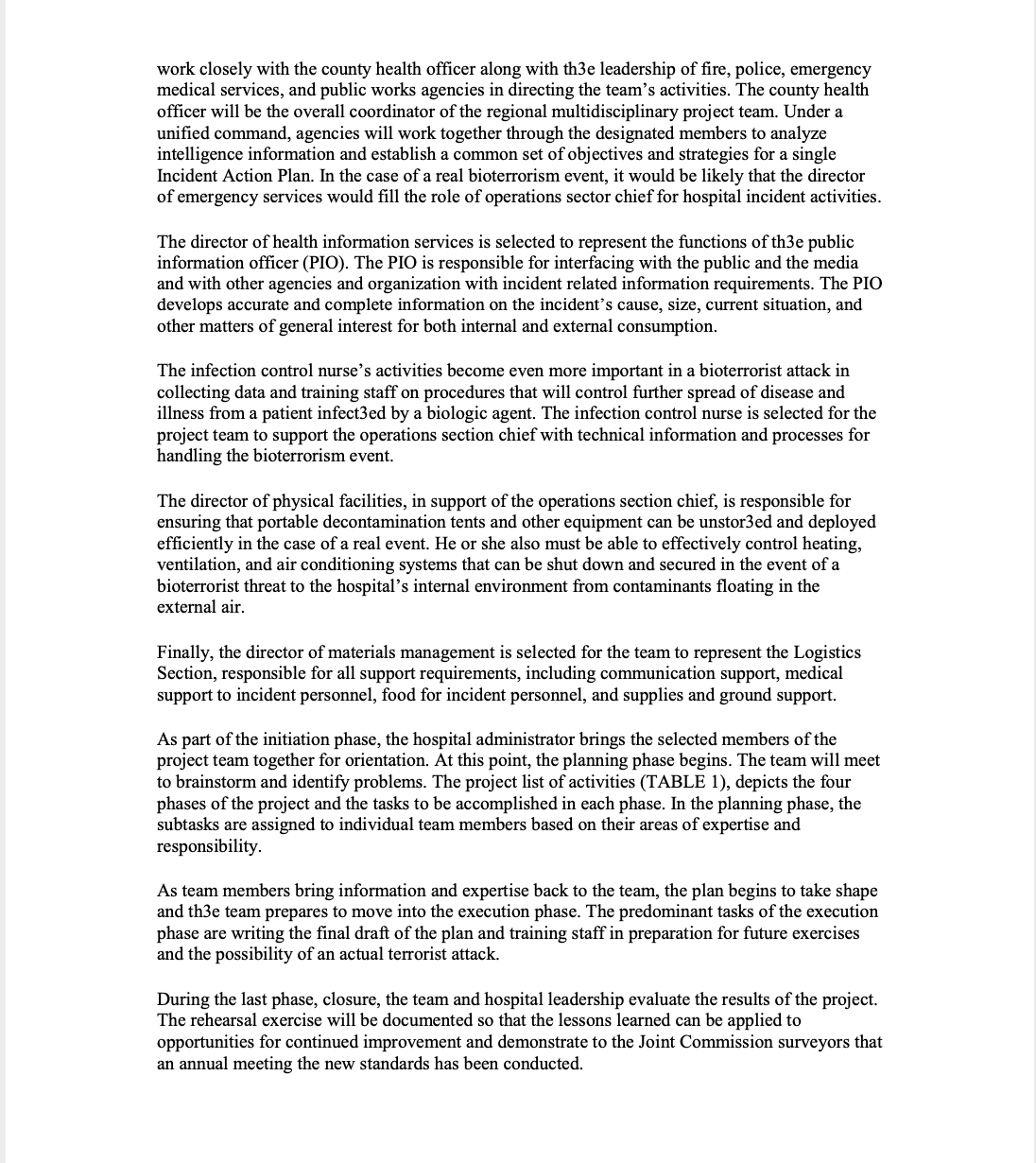
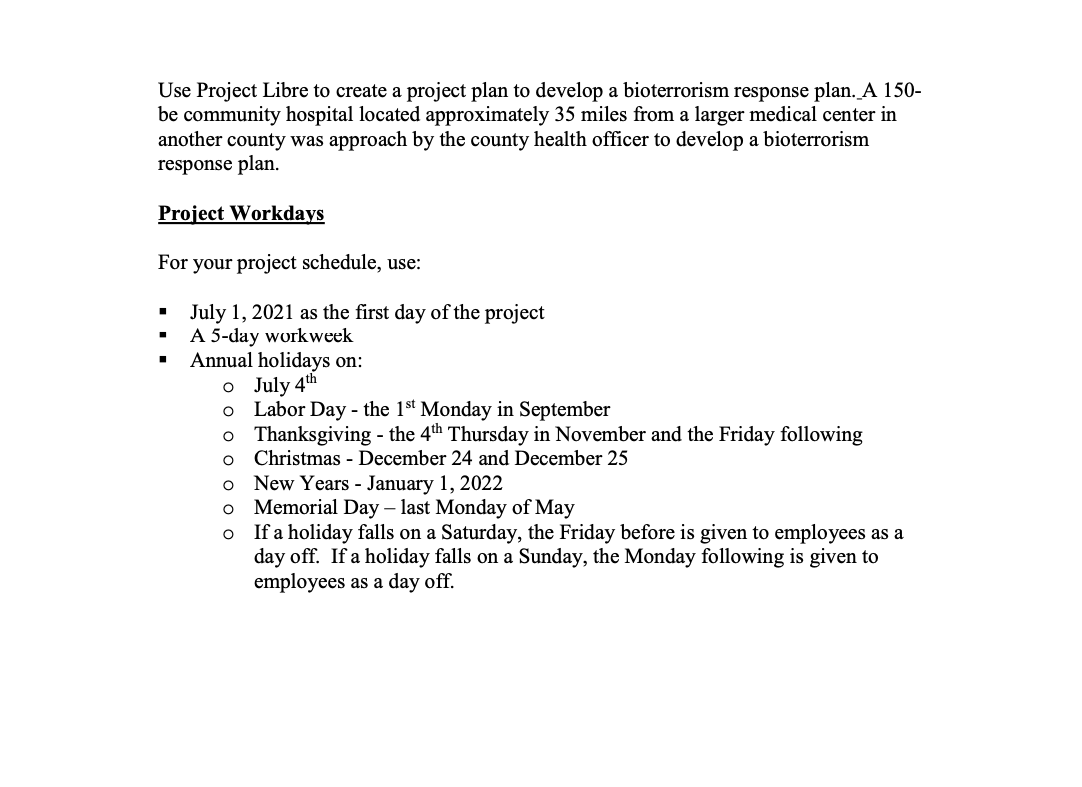
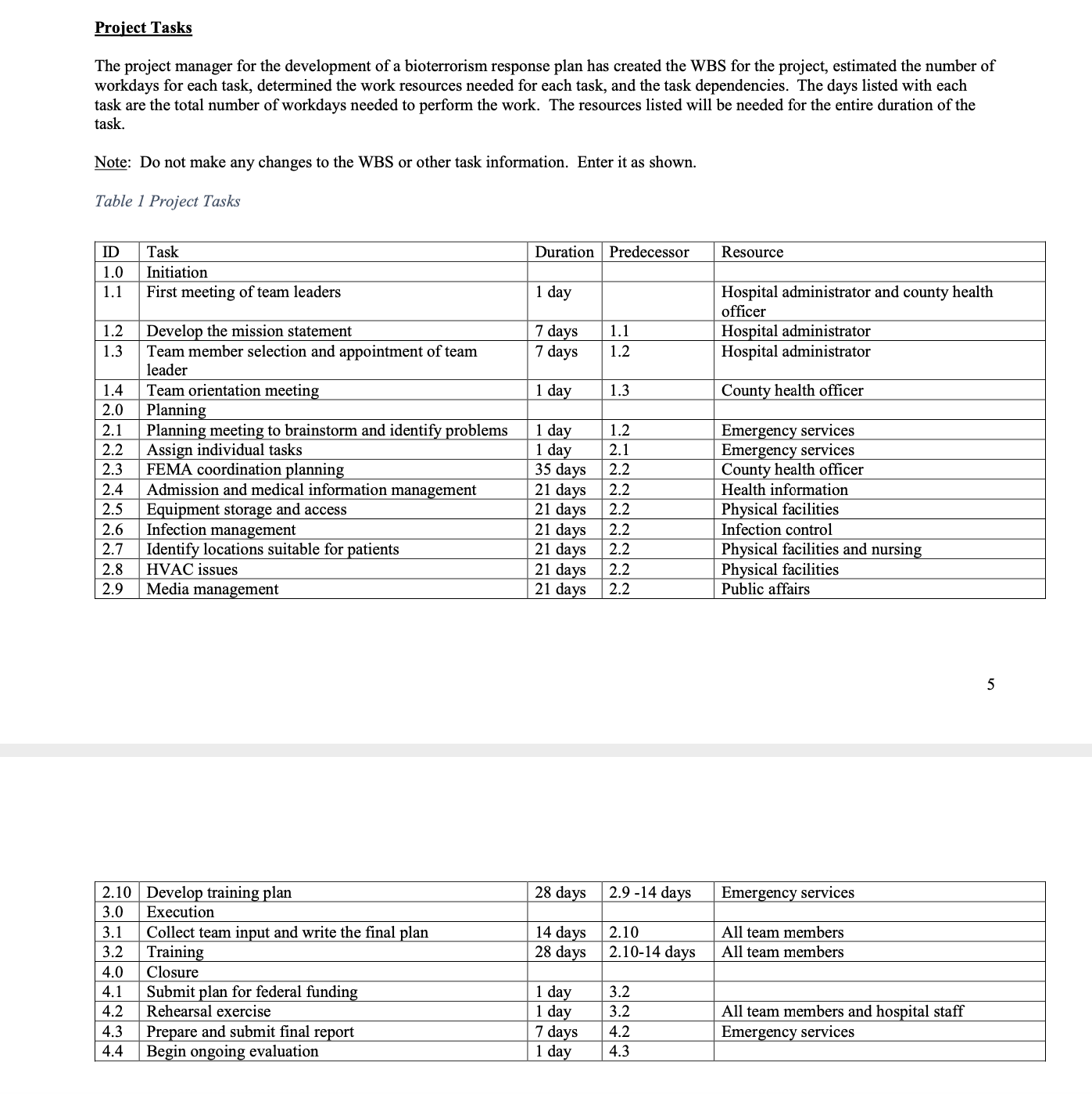
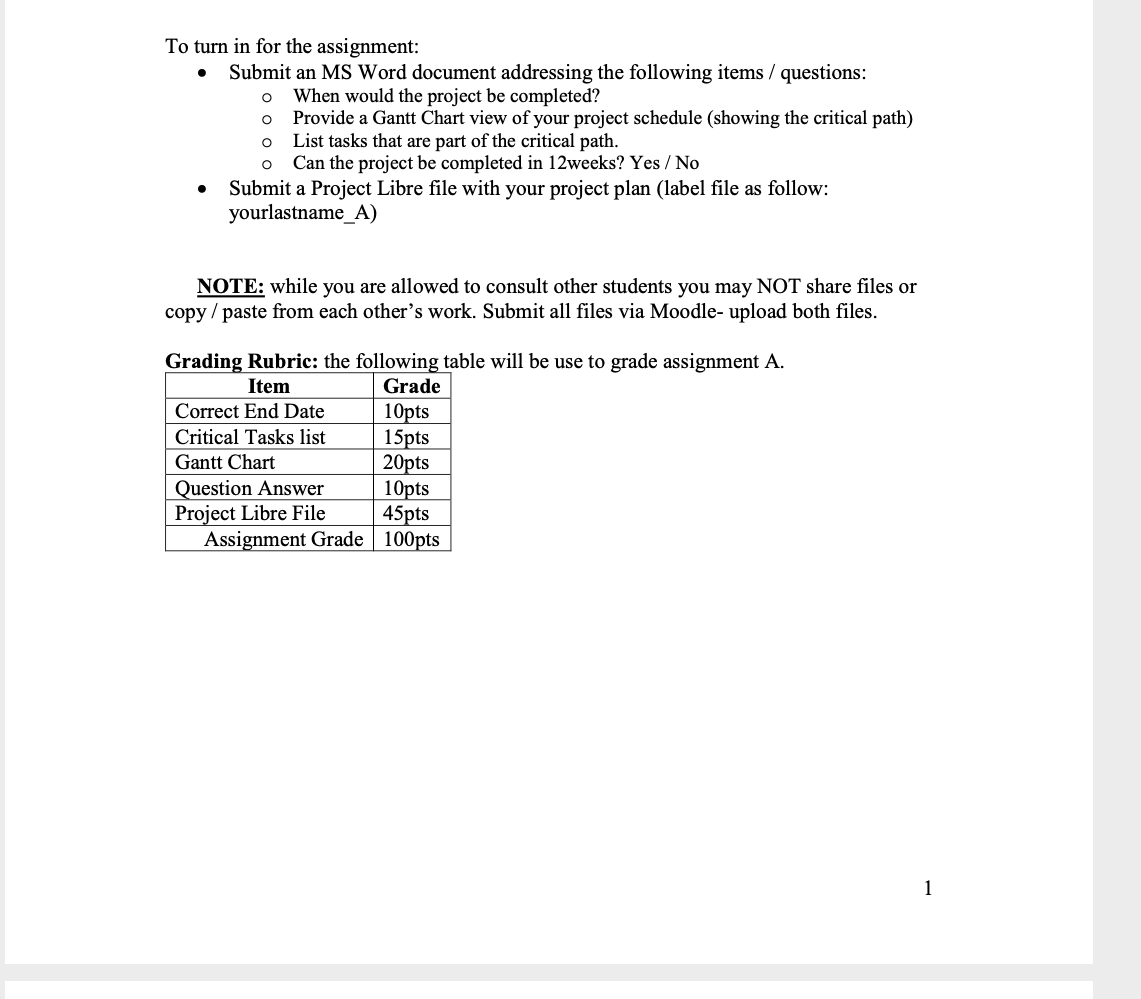

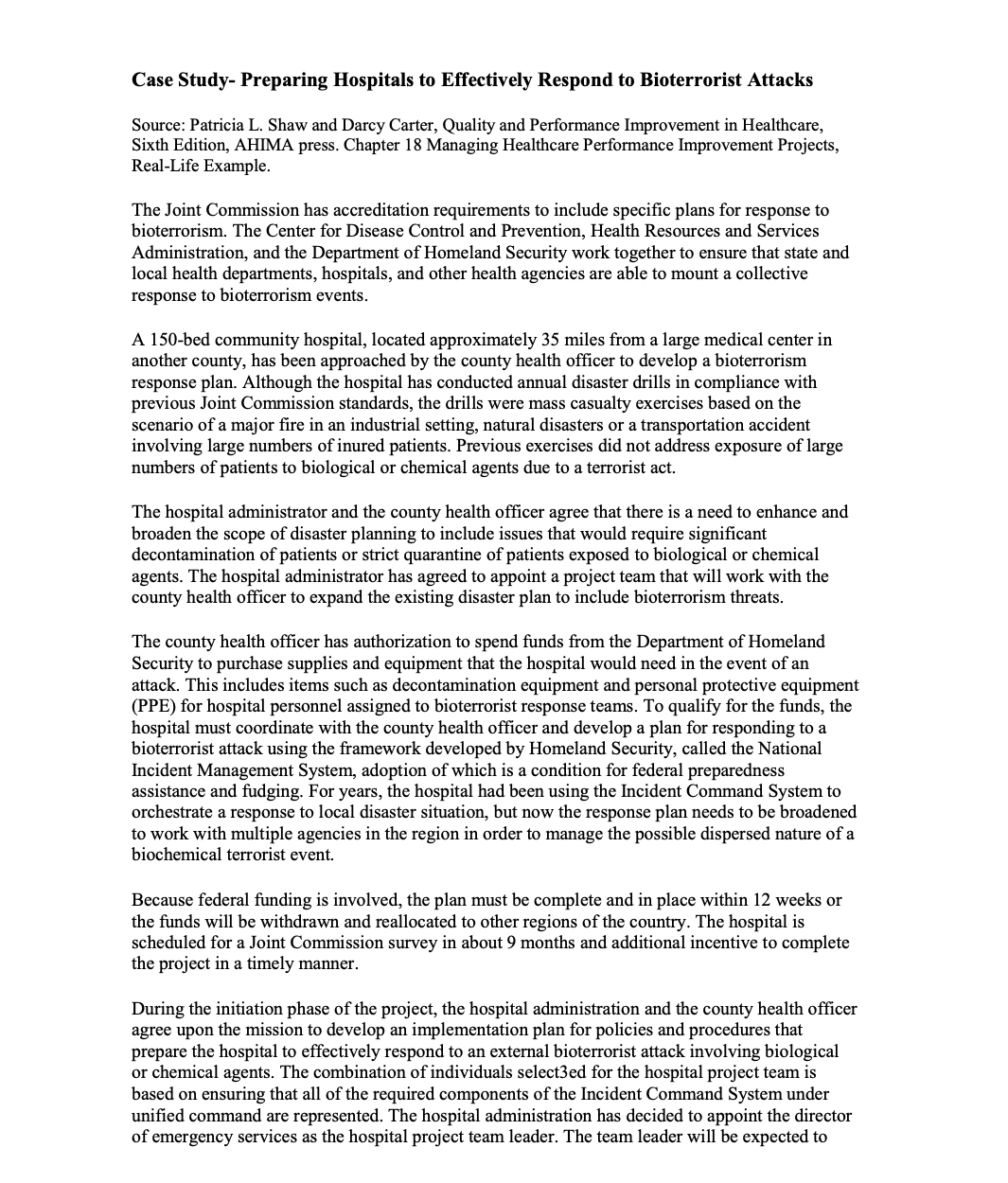 Project Tasks The project manager for the development of a bioterrorism response plan has created the WBS for the project, estimated the number of workdays for each task, determined the work resources needed for each task, and the task dependencies. The days listed with each task are the total number of workdays needed to perform the work. The resources listed will be needed for the entire duration of the task. Note: Do not make any changes to the WBS or other task information. Enter it as shown. Table 1 Project Tasks \begin{tabular}{|l|l|l|l|l|} \hline ID & Task & Duration & Predecessor & Resource \\ \hline 1.0 & Initiation & & & \\ \hline 1.1 & First meeting of team leaders & 1 day & & Hospitaladministratorandcountyhealthofficer \\ \hline 1.2 & Develop the mission statement & 7 days & 1.1 & Hospital administrator \\ \hline 1.3 & Teammemberselectionandappointmentofteamleader & 7 days & 1.2 & Hospital administrator \\ \hline 1.4 & Team orientation meeting & 1 day & 1.3 & County health officer \\ \hline 2.0 & Planning & & & \\ \hline 2.1 & Planning meeting to brainstorm and identify problems & 1 day & 1.2 & Emergency services \\ \hline 2.2 & Assign individual tasks & 1 day & 2.1 & Emergency services \\ \hline 2.3 & FEMA coordination planning & 35 days & 2.2 & County health officer \\ \hline 2.4 & Admission and medical information management & 21 days & 2.2 & Health information \\ \hline 2.5 & Equipment storage and access & 21 days & 2.2 & Physical facilities \\ \hline 2.6 & Infection management & 21 days & 2.2 & Infection control \\ \hline 2.7 & Identify locations suitable for patients & 21 days & 2.2 & Physical facilities and nursing \\ \hline 2.8 & HVAC issues & 21 days & 2.2 & Physical facilities \\ \hline 2.9 & Media management & 21 days & 2.2 & Public affairs \\ \hline & & & \\ \hline \end{tabular} 5 \begin{tabular}{|l|l|l|l|l|} \hline 2.10 & Develop training plan & 28 days & 2.914 days & Emergency services \\ \hline 3.0 & Execution & & & \\ \hline 3.1 & Collect team input and write the final plan & 14 days & 2.10 & All team members \\ \hline 3.2 & Training & 28 days & 2.1014 days & All team members \\ \hline 4.0 & Closure & & & \\ \hline 4.1 & Submit plan for federal funding & 1 day & 3.2 & \\ \hline 4.2 & Rehearsal exercise & 1 day & 3.2 & All team members and hospital staff \\ \hline 4.3 & Prepare and submit final report & 7 days & 4.2 & Emergency services \\ \hline 4.4 & Begin ongoing evaluation & 1 day & 4.3 & \\ \hline \end{tabular} Use Project Libre to create a project plan to develop a bioterrorism response plan._A 150-be community hospital located approximately 35 miles from a larger medical center in another county was approach by the county health officer to develop a bioterrorism response plan. Project Workdays For your project schedule, use: - July 1, 2021 as the first day of the project - A 5-day workweek - Annual holidays on: July 4th - Labor Day - the 1st Monday in September - Thanksgiving - the 4th Thursday in November and the Friday following - Christmas - December 24 and December 25 o New Years - January 1, 2022 - Memorial Day - last Monday of May - If a holiday falls on a Saturday, the Friday before is given to employees as a day off. If a holiday falls on a Sunday, the Monday following is given to employees as a day off. To turn in for the assignment: - Submit an MS Word document addressing the following items / questions: - When would the project be completed? - Provide a Gantt Chart view of your project schedule (showing the critical path) - List tasks that are part of the critical path. - Can the project be completed in 12weeks? Yes / No - Submit a Project Libre file with your project plan (label file as follow: yourlastname_A) NOTE: while you are allowed to consult other students you may NOT share files or copy / paste from each other's work. Submit all files via Moodle- upload both files. Grading Rubric: the following table will be use to grade assignment A. 1 Case Study- Preparing Hospitals to Effectively Respond to Bioterrorist Attacks Source: Patricia L. Shaw and Darcy Carter, Quality and Performance Improvement in Healthcare, Sixth Edition, AHIMA press. Chapter 18 Managing Healthcare Performance Improvement Projects, Real-Life Example. The Joint Commission has accreditation requirements to include specific plans for response to bioterrorism. The Center for Disease Control and Prevention, Health Resources and Services Administration, and the Department of Homeland Security work together to ensure that state and local health departments, hospitals, and other health agencies are able to mount a collective response to bioterrorism events. A 150-bed community hospital, located approximately 35 miles from a large medical center in another county, has been approached by the county health officer to develop a bioterrorism response plan. Although the hospital has conducted annual disaster drills in compliance with previous Joint Commission standards, the drills were mass casualty exercises based on the scenario of a major fire in an industrial setting, natural disasters or a transportation accident involving large numbers of inured patients. Previous exercises did not address exposure of large numbers of patients to biological or chemical agents due to a terrorist act. The hospital administrator and the county health officer agree that there is a need to enhance and broaden the scope of disaster planning to include issues that would require significant decontamination of patients or strict quarantine of patients exposed to biological or chemical agents. The hospital administrator has agreed to appoint a project team that will work with the county health officer to expand the existing disaster plan to include bioterrorism threats. The county health officer has authorization to spend funds from the Department of Homeland Security to purchase supplies and equipment that the hospital would need in the event of an attack. This includes items such as decontamination equipment and personal protective equipment (PPE) for hospital personnel assigned to bioterrorist response teams. To qualify for the funds, the hospital must coordinate with the county health officer and develop a plan for responding to a bioterrorist attack using the framework developed by Homeland Security, called the National Incident Management System, adoption of which is a condition for federal preparedness assistance and fudging. For years, the hospital had been using the Incident Command System to orchestrate a response to local disaster situation, but now the response plan needs to be broadened to work with multiple agencies in the region in order to manage the possible dispersed nature of a biochemical terrorist event. Because federal funding is involved, the plan must be complete and in place within 12 weeks or the funds will be withdrawn and reallocated to other regions of the country. The hospital is scheduled for a Joint Commission survey in about 9 months and additional incentive to complete the project in a timely manner. During the initiation phase of the project, the hospital administration and the county health officer agree upon the mission to develop an implementation plan for policies and procedures that prepare the hospital to effectively respond to an external bioterrorist attack involving biological or chemical agents. The combination of individuals select3ed for the hospital project team is based on ensuring that all of the required components of the Incident Command System under unified command are represented. The hospital administration has decided to appoint the director of emergency services as the hospital project team leader. The team leader will be expected to work closely with the county health officer along with th3e leadership of fire, police, emergency medical services, and public works agencies in directing the team's activities. The county health officer will be the overall coordinator of the regional multidisciplinary project team. Under a unified command, agencies will work together through the designated members to analyze intelligence information and establish a common set of objectives and strategies for a single Incident Action Plan. In the case of a real bioterrorism event, it would be likely that the director of emergency services would fill the role of operations sector chief for hospital incident activities. The director of health information services is selected to represent the functions of th3e public information officer (PIO). The PIO is responsible for interfacing with the public and the media and with other agencies and organization with incident related information requirements. The PIO develops accurate and complete information on the incident's cause, size, current situation, and other matters of general interest for both internal and external consumption. The infection control nurse's activities become even more important in a bioterrorist attack in collecting data and training staff on procedures that will control further spread of disease and illness from a patient infect3ed by a biologic agent. The infection control nurse is selected for the project team to support the operations section chief with technical information and processes for handling the bioterrorism event. The director of physical facilities, in support of the operations section chief, is responsible for ensuring that portable decontamination tents and other equipment can be unstor3ed and deployed efficiently in the case of a real event. He or she also must be able to effectively control heating, ventilation, and air conditioning systems that can be shut down and secured in the event of a bioterrorist threat to the hospital's internal environment from contaminants floating in the external air. Finally, the director of materials management is selected for the team to represent the Logistics Section, responsible for all support requirements, including communication support, medical support to incident personnel, food for incident personnel, and supplies and ground support. As part of the initiation phase, the hospital administrator brings the selected members of the project team together for orientation. At this point, the planning phase begins. The team will meet to brainstorm and identify problems. The project list of activities (TABLE 1), depicts the four phases of the project and the tasks to be accomplished in each phase. In the planning phase, the subtasks are assigned to individual team members based on their areas of expertise and responsibility. As team members bring information and expertise back to the team, the plan begins to take shape and th3e team prepares to move into the execution phase. The predominant tasks of the execution phase are writing the final draft of the plan and training staff in preparation for future exercises and the possibility of an actual terrorist attack. During the last phase, closure, the team and hospital leadership evaluate the results of the project. The rehearsal exercise will be documented so that the lessons learned can be applied to opportunities for continued improvement and demonstrate to the Joint Commission surveyors that an annual meeting the new standards has been conducted. Notes: 1. Enter all of the task descriptions from the WBS in the Task Name column (e.g., First meeting of team leaders). Be sure to include "Bioterrorism Response Plan" as the first (highest-level) task. - You can enter the task information manually line-by-line, but an easier way to do this is to 'copy' the first column in the WBS table in this Word document and 'paste' it in the Task Name Column in Project Libre. Use "Indent Task" arrows on the Task tab to structure your tasks as shown on the previous page. WBS numbers (if you enter the task information manually): If you enter the task information manually instead of copy/paste, you do not need to enter the corresponding WBS numbers. Just type in the task descriptions and then use indent to structure your tasks as shown. After indenting, to add WBS numbers, check the "Outline Number" box on the Format page. 2. For all WBS activities, select "Auto Scheduled" as the Task Mode. Project Libre will then automatically calculate the start and end dates for each task based on predecessor information and the work calendar. (There is also a manually scheduled mode where you can specify particular dates, but we will not use this.) When you have selected the Auto Scheduled mode, you will see blue oval/white arrow symbols in the Task Mode column. If you see a 'stick pin' symbol in that column (meaning manually scheduled), you need to change it to Auto Scheduled. 3. Specifying predecessors: The first column of the sheet where you enter your tasks is a Task ID column. Use the ID number to specify predecessor tasks
Project Tasks The project manager for the development of a bioterrorism response plan has created the WBS for the project, estimated the number of workdays for each task, determined the work resources needed for each task, and the task dependencies. The days listed with each task are the total number of workdays needed to perform the work. The resources listed will be needed for the entire duration of the task. Note: Do not make any changes to the WBS or other task information. Enter it as shown. Table 1 Project Tasks \begin{tabular}{|l|l|l|l|l|} \hline ID & Task & Duration & Predecessor & Resource \\ \hline 1.0 & Initiation & & & \\ \hline 1.1 & First meeting of team leaders & 1 day & & Hospitaladministratorandcountyhealthofficer \\ \hline 1.2 & Develop the mission statement & 7 days & 1.1 & Hospital administrator \\ \hline 1.3 & Teammemberselectionandappointmentofteamleader & 7 days & 1.2 & Hospital administrator \\ \hline 1.4 & Team orientation meeting & 1 day & 1.3 & County health officer \\ \hline 2.0 & Planning & & & \\ \hline 2.1 & Planning meeting to brainstorm and identify problems & 1 day & 1.2 & Emergency services \\ \hline 2.2 & Assign individual tasks & 1 day & 2.1 & Emergency services \\ \hline 2.3 & FEMA coordination planning & 35 days & 2.2 & County health officer \\ \hline 2.4 & Admission and medical information management & 21 days & 2.2 & Health information \\ \hline 2.5 & Equipment storage and access & 21 days & 2.2 & Physical facilities \\ \hline 2.6 & Infection management & 21 days & 2.2 & Infection control \\ \hline 2.7 & Identify locations suitable for patients & 21 days & 2.2 & Physical facilities and nursing \\ \hline 2.8 & HVAC issues & 21 days & 2.2 & Physical facilities \\ \hline 2.9 & Media management & 21 days & 2.2 & Public affairs \\ \hline & & & \\ \hline \end{tabular} 5 \begin{tabular}{|l|l|l|l|l|} \hline 2.10 & Develop training plan & 28 days & 2.914 days & Emergency services \\ \hline 3.0 & Execution & & & \\ \hline 3.1 & Collect team input and write the final plan & 14 days & 2.10 & All team members \\ \hline 3.2 & Training & 28 days & 2.1014 days & All team members \\ \hline 4.0 & Closure & & & \\ \hline 4.1 & Submit plan for federal funding & 1 day & 3.2 & \\ \hline 4.2 & Rehearsal exercise & 1 day & 3.2 & All team members and hospital staff \\ \hline 4.3 & Prepare and submit final report & 7 days & 4.2 & Emergency services \\ \hline 4.4 & Begin ongoing evaluation & 1 day & 4.3 & \\ \hline \end{tabular} Use Project Libre to create a project plan to develop a bioterrorism response plan._A 150-be community hospital located approximately 35 miles from a larger medical center in another county was approach by the county health officer to develop a bioterrorism response plan. Project Workdays For your project schedule, use: - July 1, 2021 as the first day of the project - A 5-day workweek - Annual holidays on: July 4th - Labor Day - the 1st Monday in September - Thanksgiving - the 4th Thursday in November and the Friday following - Christmas - December 24 and December 25 o New Years - January 1, 2022 - Memorial Day - last Monday of May - If a holiday falls on a Saturday, the Friday before is given to employees as a day off. If a holiday falls on a Sunday, the Monday following is given to employees as a day off. To turn in for the assignment: - Submit an MS Word document addressing the following items / questions: - When would the project be completed? - Provide a Gantt Chart view of your project schedule (showing the critical path) - List tasks that are part of the critical path. - Can the project be completed in 12weeks? Yes / No - Submit a Project Libre file with your project plan (label file as follow: yourlastname_A) NOTE: while you are allowed to consult other students you may NOT share files or copy / paste from each other's work. Submit all files via Moodle- upload both files. Grading Rubric: the following table will be use to grade assignment A. 1 Case Study- Preparing Hospitals to Effectively Respond to Bioterrorist Attacks Source: Patricia L. Shaw and Darcy Carter, Quality and Performance Improvement in Healthcare, Sixth Edition, AHIMA press. Chapter 18 Managing Healthcare Performance Improvement Projects, Real-Life Example. The Joint Commission has accreditation requirements to include specific plans for response to bioterrorism. The Center for Disease Control and Prevention, Health Resources and Services Administration, and the Department of Homeland Security work together to ensure that state and local health departments, hospitals, and other health agencies are able to mount a collective response to bioterrorism events. A 150-bed community hospital, located approximately 35 miles from a large medical center in another county, has been approached by the county health officer to develop a bioterrorism response plan. Although the hospital has conducted annual disaster drills in compliance with previous Joint Commission standards, the drills were mass casualty exercises based on the scenario of a major fire in an industrial setting, natural disasters or a transportation accident involving large numbers of inured patients. Previous exercises did not address exposure of large numbers of patients to biological or chemical agents due to a terrorist act. The hospital administrator and the county health officer agree that there is a need to enhance and broaden the scope of disaster planning to include issues that would require significant decontamination of patients or strict quarantine of patients exposed to biological or chemical agents. The hospital administrator has agreed to appoint a project team that will work with the county health officer to expand the existing disaster plan to include bioterrorism threats. The county health officer has authorization to spend funds from the Department of Homeland Security to purchase supplies and equipment that the hospital would need in the event of an attack. This includes items such as decontamination equipment and personal protective equipment (PPE) for hospital personnel assigned to bioterrorist response teams. To qualify for the funds, the hospital must coordinate with the county health officer and develop a plan for responding to a bioterrorist attack using the framework developed by Homeland Security, called the National Incident Management System, adoption of which is a condition for federal preparedness assistance and fudging. For years, the hospital had been using the Incident Command System to orchestrate a response to local disaster situation, but now the response plan needs to be broadened to work with multiple agencies in the region in order to manage the possible dispersed nature of a biochemical terrorist event. Because federal funding is involved, the plan must be complete and in place within 12 weeks or the funds will be withdrawn and reallocated to other regions of the country. The hospital is scheduled for a Joint Commission survey in about 9 months and additional incentive to complete the project in a timely manner. During the initiation phase of the project, the hospital administration and the county health officer agree upon the mission to develop an implementation plan for policies and procedures that prepare the hospital to effectively respond to an external bioterrorist attack involving biological or chemical agents. The combination of individuals select3ed for the hospital project team is based on ensuring that all of the required components of the Incident Command System under unified command are represented. The hospital administration has decided to appoint the director of emergency services as the hospital project team leader. The team leader will be expected to work closely with the county health officer along with th3e leadership of fire, police, emergency medical services, and public works agencies in directing the team's activities. The county health officer will be the overall coordinator of the regional multidisciplinary project team. Under a unified command, agencies will work together through the designated members to analyze intelligence information and establish a common set of objectives and strategies for a single Incident Action Plan. In the case of a real bioterrorism event, it would be likely that the director of emergency services would fill the role of operations sector chief for hospital incident activities. The director of health information services is selected to represent the functions of th3e public information officer (PIO). The PIO is responsible for interfacing with the public and the media and with other agencies and organization with incident related information requirements. The PIO develops accurate and complete information on the incident's cause, size, current situation, and other matters of general interest for both internal and external consumption. The infection control nurse's activities become even more important in a bioterrorist attack in collecting data and training staff on procedures that will control further spread of disease and illness from a patient infect3ed by a biologic agent. The infection control nurse is selected for the project team to support the operations section chief with technical information and processes for handling the bioterrorism event. The director of physical facilities, in support of the operations section chief, is responsible for ensuring that portable decontamination tents and other equipment can be unstor3ed and deployed efficiently in the case of a real event. He or she also must be able to effectively control heating, ventilation, and air conditioning systems that can be shut down and secured in the event of a bioterrorist threat to the hospital's internal environment from contaminants floating in the external air. Finally, the director of materials management is selected for the team to represent the Logistics Section, responsible for all support requirements, including communication support, medical support to incident personnel, food for incident personnel, and supplies and ground support. As part of the initiation phase, the hospital administrator brings the selected members of the project team together for orientation. At this point, the planning phase begins. The team will meet to brainstorm and identify problems. The project list of activities (TABLE 1), depicts the four phases of the project and the tasks to be accomplished in each phase. In the planning phase, the subtasks are assigned to individual team members based on their areas of expertise and responsibility. As team members bring information and expertise back to the team, the plan begins to take shape and th3e team prepares to move into the execution phase. The predominant tasks of the execution phase are writing the final draft of the plan and training staff in preparation for future exercises and the possibility of an actual terrorist attack. During the last phase, closure, the team and hospital leadership evaluate the results of the project. The rehearsal exercise will be documented so that the lessons learned can be applied to opportunities for continued improvement and demonstrate to the Joint Commission surveyors that an annual meeting the new standards has been conducted. Notes: 1. Enter all of the task descriptions from the WBS in the Task Name column (e.g., First meeting of team leaders). Be sure to include "Bioterrorism Response Plan" as the first (highest-level) task. - You can enter the task information manually line-by-line, but an easier way to do this is to 'copy' the first column in the WBS table in this Word document and 'paste' it in the Task Name Column in Project Libre. Use "Indent Task" arrows on the Task tab to structure your tasks as shown on the previous page. WBS numbers (if you enter the task information manually): If you enter the task information manually instead of copy/paste, you do not need to enter the corresponding WBS numbers. Just type in the task descriptions and then use indent to structure your tasks as shown. After indenting, to add WBS numbers, check the "Outline Number" box on the Format page. 2. For all WBS activities, select "Auto Scheduled" as the Task Mode. Project Libre will then automatically calculate the start and end dates for each task based on predecessor information and the work calendar. (There is also a manually scheduled mode where you can specify particular dates, but we will not use this.) When you have selected the Auto Scheduled mode, you will see blue oval/white arrow symbols in the Task Mode column. If you see a 'stick pin' symbol in that column (meaning manually scheduled), you need to change it to Auto Scheduled. 3. Specifying predecessors: The first column of the sheet where you enter your tasks is a Task ID column. Use the ID number to specify predecessor tasks Step by Step Solution
There are 3 Steps involved in it
Step: 1

Get Instant Access to Expert-Tailored Solutions
See step-by-step solutions with expert insights and AI powered tools for academic success
Step: 2

Step: 3

Ace Your Homework with AI
Get the answers you need in no time with our AI-driven, step-by-step assistance
Get Started


